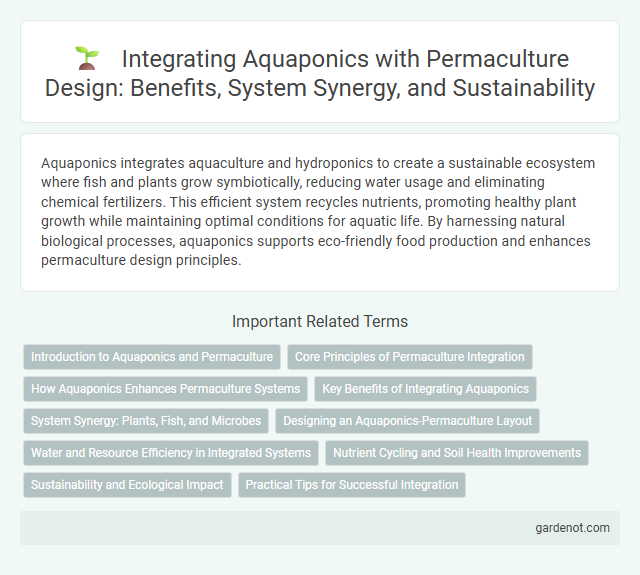Aquaponics integrates aquaculture and hydroponics to create a sustainable ecosystem where fish and plants grow symbiotically, reducing water usage and eliminating chemical fertilizers. This efficient system recycles nutrients, promoting healthy plant growth while maintaining optimal conditions for aquatic life. By harnessing natural biological processes, aquaponics supports eco-friendly food production and enhances permaculture design principles.
Introduction to Aquaponics and Permaculture
Aquaponics integrates aquaculture and hydroponics to create a sustainable, symbiotic ecosystem where fish waste provides nutrients for plants, and plants naturally filter water for fish. This innovative method aligns with permaculture principles by promoting food production that mimics natural ecosystems, conserves water, and enhances biodiversity. Implementing aquaponics within permaculture systems boosts efficiency and resilience, supporting regenerative agriculture and sustainable living.
Core Principles of Permaculture Integration
Aquaponics exemplifies the core principles of permaculture integration by combining aquaculture and hydroponics into a closed-loop system that maximizes resource efficiency and sustainability. Nutrient-rich water from fish tanks nourishes plants, which in turn purify the water, creating a balanced ecosystem that reduces waste and enhances productivity. This symbiotic relationship reflects permaculture's emphasis on interconnected systems, closed nutrient cycles, and sustainable food production.
How Aquaponics Enhances Permaculture Systems
Aquaponics enhances permaculture systems by integrating aquaculture and hydroponics to create a symbiotic environment where fish waste provides natural fertilizer for plants, reducing the need for synthetic inputs. This closed-loop system promotes water efficiency, recycling nutrient-rich water between the fish tanks and grow beds, which conserves resources and supports sustainable food production. Incorporating aquaponics within permaculture designs increases biodiversity, improves soil health, and boosts overall ecosystem productivity.
Key Benefits of Integrating Aquaponics
Integrating aquaponics in permaculture systems enhances sustainability by combining fish farming and hydroponic plant cultivation, optimizing resource efficiency through nutrient recycling. This symbiotic setup reduces water usage by up to 90% compared to traditional agriculture while producing organic vegetables and protein-rich fish simultaneously. Aquaponics also minimizes chemical inputs and supports biodiversity, making it ideal for eco-friendly and resilient food production.
System Synergy: Plants, Fish, and Microbes
Aquaponics integrates plants, fish, and microbes into a self-sustaining ecosystem where fish provide nutrient-rich waste that microbes convert into essential nutrients for plants. Plants absorb these nutrients, purifying the water which then recirculates back to the fish tanks, creating a closed-loop system. This synergy enhances resource efficiency while promoting sustainable food production within permaculture frameworks.
Designing an Aquaponics-Permaculture Layout
Designing an aquaponics-permaculture layout involves integrating fish tanks, grow beds, and water circulation systems to create a sustainable ecosystem that maximizes nutrient recycling and water efficiency. Key considerations include optimizing plant placement for light exposure, selecting compatible fish and crops, and incorporating companion planting to enhance pest control and productivity. Efficient layout design reduces waste, conserves resources, and supports continuous food production within permaculture principles.
Water and Resource Efficiency in Integrated Systems
Aquaponics maximizes water efficiency by recycling nutrient-rich water between fish tanks and plant beds, reducing overall water consumption by up to 90% compared to traditional agriculture. This integrated system leverages biological nitrification to convert fish waste into essential nutrients for plants, minimizing the need for synthetic fertilizers. The closed-loop design optimizes resource use, promoting sustainable food production with minimal environmental impact.
Nutrient Cycling and Soil Health Improvements
Aquaponics integrates fish farming and hydroponics to create a closed-loop system where fish waste provides essential nutrients for plant growth, enhancing nutrient cycling efficiency. This method reduces reliance on synthetic fertilizers, promoting soil health by minimizing chemical runoff and encouraging beneficial microbial activity. Improved nutrient availability in aquaponics supports robust plant development, leading to sustainable agricultural practices that maintain long-term soil vitality.
Sustainability and Ecological Impact
Aquaponics integrates aquaculture and hydroponics to create a sustainable food production system that minimizes water use by recycling nutrient-rich water from fish tanks to plants. This closed-loop system reduces reliance on chemical fertilizers and lowers environmental pollution, promoting biodiversity and ecosystem health. By enhancing resource efficiency, aquaponics supports regenerative agriculture practices essential for long-term ecological balance.
Practical Tips for Successful Integration
Integrate aquaponics into permaculture by selecting compatible plant species such as leafy greens and herbs that thrive in nutrient-rich water from fish tanks. Maintain water quality through regular monitoring of pH levels between 6.8 and 7.2, ammonia, nitrites, and nitrates to ensure a balanced ecosystem supporting both aquatic life and plant growth. Optimize system efficiency with proper fish stocking densities, typically 1 pound of fish per 5 gallons of water, and use aeration techniques to enhance oxygen levels for healthy fish and robust plant development.
Aquaponics Infographic

 gardenot.com
gardenot.com